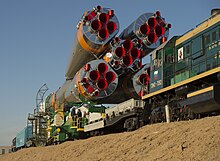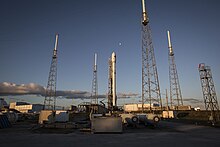發射台
此條目目前正依照其他維基百科上的內容進行翻譯。 (2023年8月15日) |
發射台是一種設計為發射火箭能驅動飛行器的地面設施(包括運載火箭、穿梭機、彈道導彈等在內)[1],可用於固定和支撐火箭並為火箭和載荷提供維護支持。發射台大致可分為固定式發射台和移動式發射台,其中移動式發射台可以在公路或鐵路上進行移動[2]。

大多數發射台都包括固定的服務結構,以提供一個或多個進入平台來組裝、檢查和維護運載工具,並允許進入航天器,包括裝載機組人員。 該墊可以包含火焰偏轉結構,以防止火箭排氣的強熱損壞飛行器或墊結構,並且可以採用噴灑大量水的聲音抑制系統。 該墊也可以受到避雷器的保護。 航天發射場通常包括多個發射場和其他支持基礎設施。
Most launch pads include fixed service structures to provide one or more access platforms to assemble, inspect, and maintain the vehicle and to allow access to the spacecraft, including the loading of crew. The pad may contain a flame deflection structure to prevent the intense heat of the rocket exhaust from damaging the vehicle or pad structures, and a sound suppression system spraying large quantities of water may be employed. The pad may also be protected by lightning arresters. A spaceport typically includes multiple launch complexes and other supporting infrastructure.
The launch complex for liquid fueled rockets often has extensive ground support equipment including propellant tanks and plumbing to fill the rocket before launch. Cryogenic propellants (liquid oxygen oxidizer, and liquid hydrogen or liquid methane fuel) need to be continuously topped off (i.e., boil-off replaced) during the launch sequence (countdown), as the vehicle awaits liftoff. This becomes particularly important as complex sequences may be interrupted by planned or unplanned holds to fix problems.
Most rockets need to be supported and held down for a few seconds after ignition while the engines build up to full thrust. The vehicle is commonly held on the pad by hold-down arms or explosive bolts, which are triggered when the vehicle is stable and ready to fly, at which point all umbilical connections with the pad are released.
Transport of rockets to the pad
編輯此section可能包含原創研究。 (2018年11月1日) |



Each launch site is unique, but a few broad types can be described by the means by which the space vehicle gets to the pad.[來源請求]
- Horizontally integrated rockets travel horizontally with the tail forward to the launch site on a transporter erector launcher and are then raised to the vertical position over the flame duct. Examples include all large Soviet rockets, including Soyuz, Proton, N1, and Energia. This method is also used by the SpaceX and Electron launch vehicles.
- Silo launched rockets are assembled inside of a missile silo. This method is only used by converted ICBMs due to the difficulty and expense of constructing a silo that can contain the forces of a rocket launch.
- Vertically integrated rockets can be assembled in a separate hangar on a mobile launcher platform (MLP). The MLP contains the umbilical structure and is carried to the launch site on a large vehicle called Crawler-transporter. Launch Complex 39 at the Kennedy Space Center is an example of a facility using this method.[3] A similar system is used to launch Ariane 5 rockets at ELA-3 at Guiana Space Centre.
- Vertically assembled vehicles can also be transported on a mobile launcher platform resting on two parallel standard gauge railroad tracks that run from the integration building to launch area. This system is still in use for the Atlas V and future Vulcan.
- At SLC-6 and SLC-37, rockets are assembled on the launch mount. A windowless rail-mounted building encloses the launch pad and gantry to protect the vehicle from the elements, and for purposes of military secrecy. Prior to launch,[4] the building is rolled away. This method is also used at Kagoshima for the M-V.
- The former Sea Launch service used the converted self-propelled oil drilling platform Ocean Odyssey to transport Zenit 3SL rockets horizontally to the Equator, and then to erect and launch them from a floating launch platform into geostationary transfer orbits.
發射台的類型
編輯其中綜合發射系統通常包括一個用於支撐火箭的發射架或發射平台(即狹義上的「發射台」)、一個帶有臍帶纜的服務結構(通稱「臍帶塔」),以及一套用於提供推進劑、電力、通信、遙測、散熱、火箭組裝、有效載荷處理和存儲設施所需的勤務設施(通稱「勤務塔」)[5],而以上所述的各個結構在實際設計時其功能可能會被合併至同一個建築中去(如921發射工位的發射塔架便集成了勤務塔和臍帶塔的功能[6])。
參見
編輯- Ground segment——火箭發射設施
- Launch vehicle——火箭發射設施
- List of rocket launch sites
- Missile launch facility
- Non-rocket spacelaunch
- Pad abort test——火箭發射設施
- Rocket launch
- Service structure——火箭發射設施
- Spaceport
- Stratolaunch Systems——火箭發射設施
- Transporter erector launcher——火箭發射設施
參考文獻
編輯- ^ Wragg, David W. A Dictionary of Aviation first. Osprey. 1973: 175. ISBN 9780850451634.
- ^ 崔吉俊主編 北京:中國宇航出版社 2010 第62頁. 《航天发射试验工程》.
- ^ LAUNCH COMPLEX 39, PADS A AND B. NASA KSC. 1992. (原始內容存檔於2008-09-21).
- ^ Cpsb Launchpad. Viswanath. 2023 [2023-08-14]. (原始內容存檔於2023-06-16).
- ^ 载人航天常见术语知识帖 | 带你从专业角度看发射!_中国载人航天官方网站. www.cmse.gov.cn. [2023-08-14]. (原始內容存檔於2023-08-14).
- ^ 《中国冶金报》:酒泉卫星发射中心的功勋塔架. tz.com.cn. 2022-06-15 [2023-08-14]. (原始內容存檔於2023-08-14) –透過太原重型機械集團有限公司 (中文).